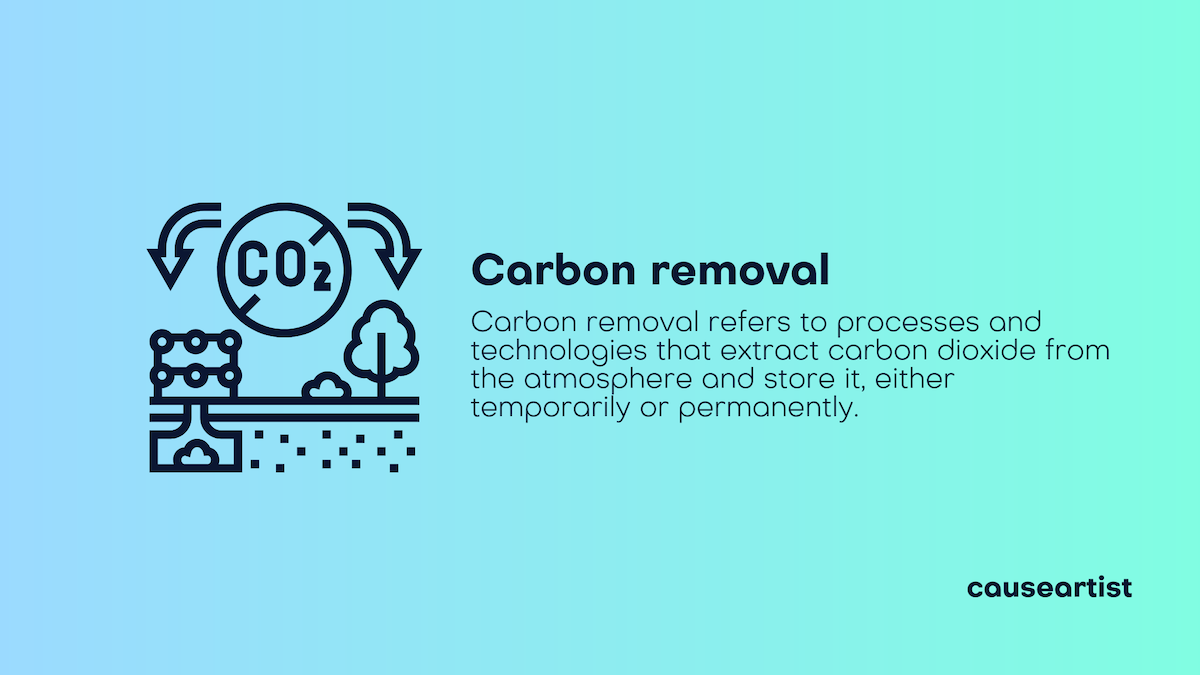Carbon removal refers to processes and technologies that extract carbon dioxide from the atmosphere and store it, either temporarily or permanently.
Unlike traditional emissions reductions, which aim to decrease the amount of new CO₂ entering the atmosphere, carbon removal directly targets the CO₂ already present in the air.
By doing so, it helps reduce the overall concentration of greenhouse gases, mitigating the warming effects they cause.
Carbon removal is crucial for reaching "net-zero" emissions, where the amount of CO₂ removed from the atmosphere equals or surpasses the amount emitted.
Why is Carbon Removal Important?
- Addressing Past Emissions: Even if we could halt all new emissions immediately, the CO₂ already in the atmosphere would continue to drive climate change. Carbon removal is essential for offsetting these historical emissions.
- Supporting Net-Zero Goals: Most international climate targets, including those outlined in the Paris Agreement, rely on achieving net-zero emissions. Carbon removal technologies can help balance out unavoidable emissions from industries like agriculture and aviation.
- Preventing Irreversible Damage: Removing CO₂ from the atmosphere can help reduce global warming, preserving ecosystems and protecting vulnerable communities from severe weather patterns, sea-level rise, and biodiversity loss.
How Does Carbon Removal Work?
Carbon removal encompasses a range of methods, which can be broadly categorized into nature-based solutions and technology-based approaches.
Each method has distinct advantages, limitations, and applications in the journey to reduce atmospheric CO₂.

Nature-Based Carbon Removal Methods
Nature-based solutions leverage ecosystems to naturally absorb CO₂, offering additional environmental benefits beyond carbon capture.
1. Reforestation and Afforestation
- How It Works: Planting new trees (afforestation) or restoring existing forests (reforestation) helps absorb CO₂ as trees convert it into biomass.
- Benefits: Inexpensive, improves biodiversity, and enhances soil and water quality.
- Challenges: Requires large land areas and may be vulnerable to climate impacts like wildfires.
2. Soil Carbon Sequestration
- How It Works: Farming techniques, such as cover cropping and no-till agriculture, increase the amount of carbon stored in the soil.
- Benefits: Boosts soil fertility and agricultural productivity while capturing CO₂.
- Challenges: Requires widespread adoption of sustainable farming practices and ongoing maintenance.
3. Wetland and Coastal Restoration
- How It Works: Coastal ecosystems, like mangroves and wetlands, can sequester large amounts of carbon in their biomass and sediment.
- Benefits: Protects coastal areas from erosion, supports marine biodiversity, and captures carbon efficiently.
- Challenges: Sensitive to climate change, land use competition, and environmental degradation.
Technology-Based Carbon Removal Methods
Technological solutions focus on capturing and storing carbon through engineered processes, often with the goal of permanent storage.
1. Direct Air Capture (DAC)
- How It Works: Specialized machines pull CO₂ from the air, which is then stored underground or used in various industrial processes.
- Benefits: Can capture CO₂ from any location, highly scalable.
- Challenges: Expensive, energy-intensive, and dependent on renewable energy sources to be sustainable.
2. Bioenergy with Carbon Capture and Storage (BECCS)
- How It Works: Biomass is used as an energy source, and the CO₂ produced during combustion is captured and stored underground.
- Benefits: Generates renewable energy while removing CO₂.
- Challenges: Competes with agriculture for land use and may impact food security if not managed carefully.
3. Mineralization and Enhanced Weathering
- How It Works: Exposing certain types of rock to CO₂ chemically binds the carbon, forming stable carbonate minerals.
- Benefits: Offers permanent carbon storage.
- Challenges: Requires large quantities of rock and can be costly to implement on a large scale.
What Are the Challenges of Carbon Removal?
While promising, carbon removal comes with several challenges:
- High Costs: Many carbon removal technologies, especially direct air capture, require significant investment to scale.
- Energy Requirements: Some methods, like DAC, need large amounts of energy to operate, ideally from renewable sources to remain carbon-neutral.
- Land Use: Nature-based solutions often require substantial land, which can create competition with agriculture, biodiversity preservation, and urban development.
- Verification and Monitoring: It’s essential to track the effectiveness of carbon removal efforts to ensure CO₂ stays sequestered over time.
Subscribe on Apple Podcasts
Subscribe on Spotify
Subscribe on Amazon Music




